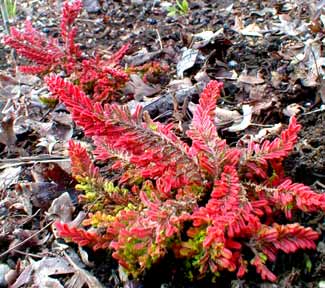
'Wickwar Flame'
Scotch Heather
"The crooked paths go every way
Upon the hill - they wind about
Through the heather in & out
Of the quiet sunniness."
-James Stephens
(1825-1901)
(1825-1901)
In the quest for more winter color in the garden, I chose two little pots of Calluna vulgaris 'Wickwar Flame,' a true heather. In spring & summer, the scale-like leaves are lime green on the underside of branches, orange & yellow on the top where exposed to full sun. Then in Autumn & especially throughout Winter, the leaves have such intense red coloration, it looks as though the little shrubs were colored with a child's red crayons.
Late summer & autumn mauve to lavender-pink flowers last until October or occasionally into November, but are not nearly as intense as the leaves. When the blooms are fading, the drying flowers should be trimmed back to where they started so that the foliage can be better displayed for the rest of the winter.
As little starts, 'Wickwar Flame' can poke its limbs straight up, & out sideways, appearing all in all to be at war with itself, limbs stabbing at right angles to themselves, in all directions. Eventually it will grow eighteen inches to two feet tall & wide, & have a more densely mounded appearance.
Though it can stand partial shade, colors will be more exciting in full sun & with windy exposures. Over-protection from the elements will not help it achieve the reddest winter colors, & will cause it to be merely green in spring & summer. That does not mean it should be abused. It does not like ever to be entirely dry, & requires acidic, loamy, moist soil, though with good drainage so as not to risk root-rot.
An old, well-rooted specimen might tolerate some droughtiness if it had to, but not without some signs of stress or injury. It is odd that many people think these are drought-hardy plants, but heathers' preferred moorland settings are perpetually damp to boggy.
I was so often told they were drought-hardy that three of my first four heathers did miserably, & are written up on a Failure with Heathers Page. Given the right balance of attention, 'Warwick Flame' is a vigorous cultivar, & justly a recipient of the Award of Garden Merit for ease of growth & extreme beauty. But heathers in general are not vigorous & hardy, let alone beautiful, if they find themselves in soil that is too soggy, too dry, too alkaline, over fertilized, or in locations that are too shady.
Only after I broke down & did my own research on heather care did I realize I had been misled about their adaptability & drought hardiness. At long last armed with better knowledge, I went out shopping anew in sundry nurseries, seeking the most deeply colored heathers. Several nurseries had only the grey-green to deep-green basic varieties with white to purple flowers, so I continued onward in my quest for winter color.
Along the search, every nursery worker I encountered mentioned, without prompting, that these shrubs were good for droughty roadside conditions. The uniformity of this misinformation was startling, though it was at least a relief to realize I hadn't dreamed up heather-murdering advice by myself, when I maltreated my very first doomed heathers.
Strangely enough, if those nursery workers would read their own pre-printed tags, they'd know their off-the-cuff advice was bass-ackward. The 'Wickwar Flame' tag was too small to say much, but managed to state explicitely: "Incorporate moist peat, water during dry weather."
So I selected a well-watered sunny part of the garden & installed the two tiny beginnings of 'Wickwar Flame,' as shown in the February photograph above.
'Wickwar Flame' is named after a village in Glouchestershire, having been developed by George Osmond (1907-1989) of Wickwar, from an earlier cultivar, 'Olympic Gold,' & released to the public in 1970. Of the various plants George Osmond developed while he ran Archfield Nursery for nearly sixty years., 'Wickwar Flame' was his greatest achievement, his single plant apt never to die out of the nursery trade around the world.